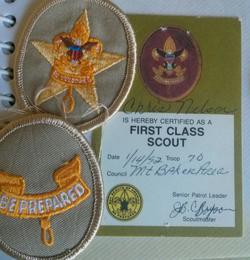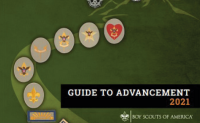 I got an e-mail from a reader:
I got an e-mail from a reader:
I’m the advancement coordinator for our troop. Recently I was running the “Scouts Not Advancing” report in Troopmaster and noticed that we have a good number of Scouts who haven’t advanced in rank in 18 months or more. One of our committee members told me that an assistant Scoutmaster used to collect the Scouts’ books, went through them to see what hadn’t been signed off, then told the PLC what requirements were missing to try to get the Scouts to help others advance. What is the best way for the committee to help move advancement along? Should we have some of the older Scouts work with the younger ones to get requirements done? How about a troop meeting where we have a session with sign-off stations?
This is an issue that seems to come up frequently. While some Scouts advance quickly through the ranks, others seem to lag behind for one reason or another, and it sometimes makes the adult leaders wonder how to help them catch up.
Disparity in advancement rates is a perfectly normal phenomenon. It’s intended that Scouts advance at their own pace, not in lock step. Advancement is one of the eight methods of Scouting, and while it’s one of the more visible methods, it’s not the most important (none are actually more important than any other).
If it’s older Scouts not advancing, it’s usually not a worry. If they’re at least Star, it’s probably because of the time it takes to complete some of the Eagle-required merit badges. If they’re Life, they have to finish several more plus a leadership service project, so they’ll likely need some additional time. Statistics show that the normal time span over which an Eagle project takes place is anywhere from 25 to 67 weeks, so a Life Scout not advancing in 18 months isn’t necessarily a cause for alarm.
Where you do need to be concerned, however, is when there are Scouts stuck at Tenderfoot or Second Class for long periods of time, and your concern should not be as much with the individual Scout but the troop program as a whole. An active Scout in his first year or two, in an active troop following the patrol method with regular outings, should advance in rank about every six to nine months just by participating in the things the troop does. Often, though, Scouts don’t show up for troop meetings or campouts, and if they do, they don’t realize that advancement is supposed to be the result of the things they do – not just an arbitrary list of things to be completed and checked off.
But adults managing the advancement process strictly for advancement’s sake is the wrong way to go about it.
In Cub Scouts, the den leader would usually collect the Scouts’ handbooks to see what had been signed off at home, fill in what was done in den meetings, and record their progress.
However, you’re not in Cub Scouts any more, and the responsibility for advancement rests with the Scouts themselves – and more specifically in the patrols. If you look at the requirements for the lower ranks, many of them require doing things with your patrol or on a patrol campout, cooking one of your patrol’s meals, participate in troop/patrol activities – you get the idea.
It should be evident from reading the requirements that the majority of them are done in the context of troop and patrol activities – not at “stations” organized by the adults where younger Scouts go around and get things signed off, as if it’s a scavenger hunt.
Troops that have an active outdoor program, where the Scouts form themselves into naturally-grouped patrols of friends and plan their own campouts, are troops where Scouts advance as a natural outcome of being Scouts. Troops where the adults have a heavy hand in planning the program aren’t as successful with advancement, largely because the Scouts don’t have as much “skin in the game.”
So back to the original question: how can the committee and other adult leaders help Scouts to advance? Here are some ways:
- The Scoutmaster should know how each Scout is coming along. This is done through individual informal chats with each Scout. It’s customary to hold a Scoutmaster conference when a Scout is ready to advance, but that’s not the only time the Scoutmaster can review an individual Scout’s progress. Ideally, there should be multiple mini-conferences on an ongoing basis.
- The patrol leaders are responsible for the welfare of the Scouts in their patrols, and should know how each Scout is doing advancement-wise. They, not the adult leaders, should be advising the patrol leaders’ council about what needs to be accomplished – things like hikes, flag ceremonies or orienteering activities. Assistant Scoutmasters can help the patrol leaders realize this and figure out how to do it.
- The Scoutmaster helps the senior patrol leader prepare for the patrol leaders’ council meeting, reviewing with him the plans for upcoming troop meetings and campouts and guiding him toward things the troop should be doing to engage as many Scouts as possible.
- The committee supports the Scoutmaster by providing resources – camping gear, transportation, supervision – so the Scouts in the troop can carry out an adventurous and engaging outdoor program.
- Finally, and most importantly, the committee promptly conducts a board of review whenever the Scoutmaster says that a Scout is ready to advance, and the advancement coordinator records the advancement with the local council.
Troops where the adults find it necessary to step in and nudge the advancement process are most likely going about it wrong. Put the troop program in the hands of those who are responsible for it – the Scouts – with proper guidance and mentoring instead of directing and usurping. Scouts will naturally gravitate toward activities that they themselves plan and conduct.
This post first appeared on Bobwhite Blather.




